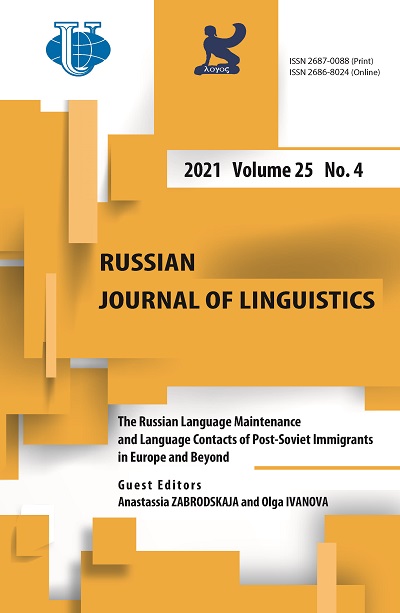Рецензия на монографию Svetlana Moskvitcheva & Alain Viaut (eds.). 2019. Minority Languages from Western Europe and Russia. Comparative Approaches and Categorical Configurations. Switzerland, Springer. ISBN 978-3-030-24339-5
- Авторы: Александрова О.И.1
-
Учреждения:
- Российский университет дружбы народов
- Выпуск: Том 25, № 4 (2021): Сохранение русского языка и языковые контакты постсоветских иммигрантов в Европе и за ее пределами
- Страницы: 1143-1149
- Раздел: РЕЦЕНЗИИ
- URL: https://journals.rudn.ru/linguistics/article/view/29741
- DOI: https://doi.org/10.22363/2687-0088-2021-25-4-1143-1149
Цитировать
Полный текст
Аннотация
-
Об авторах
Оксана Ивановна Александрова
Российский университет дружбы народов
Автор, ответственный за переписку.
Email: alexandrova-oi@rudn.ru
ORCID iD: 0000-0002-7246-4109
доцент кафедры общего и русского языкознания, заместитель декана филологического факультета по научной работе
Россия, 117198, Москва, Миклухо-Маклая, 6Список литературы
- Bakhtin, Mikhail M. 2012. Word in the Novel. Collected Works. Vol. 3. Theory of the Novel. Moscow: Yazyki slavanskih kultur. (In Russ.)
- Fishman, Joshua A. 1991. Reversing Language Shift. Clevedon: Multilingual Matters.
- Kibrik, Andrej A. 2021. A program for the preservation and revitalization of the languages of Russia. Russian Journal of Linguistics 25 (2). 507-527. https://doi.org/10.22363/2687-0088-2021-25-2-507-527
- Mihalchenko, Vida Yu. 2006. Slovar sociolingvisticheskih terminov [Dictionary of sociolinguistic terms]. Мoscow: Institut yazykoznaniâ RAN. (In Russ.)
- Varol, Marie-Christine. 1994. Languages de diaspora. Plurilinguismes 7. 1-11.
- Viaut, Alen & Moskvitcheva, Svetlana A. (eds.). 2014. La Catégorisation des Langues Minoritaires en Russie et dans L’espace Post-Soviétique. Bordeaux: Maison des sciences de l’homme d’Aquitaine.
- Wright, Sue. 2016. Language Policy and Language Planning. From Nationalism to Globalization 2nd edition. Palgrave: Macmillan.

















